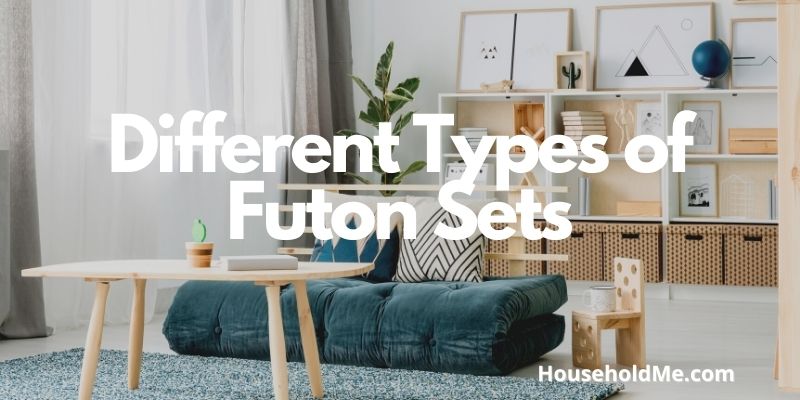In search of a brand-new futon set? Before you settle on a particular model, you should be aware of the various types of futon sets that exist.

Whether you’re a broke college kid or already have a full-time job, a futon can be an invaluable piece of living room furniture. The extreme versatility it offers makes it the perfect piece to have for guests or when you just want to kick back and chill at home.
Why You Should Get a Futon
First and foremost, futons function as both a bed and a couch. It hardly takes any work to transform from one to the other and back, and they take much less square footage than couches and bed frames. Sure, they’re not the most luxurious mode of lazing and sleeping, but if you don’t have much room to spare, this 2-in-1 furniture piece is a godsend.
Another huge benefit that we think you’ll appreciate is that futons are considerably less expensive than purchasing a couch and bed frame. Granted, they’re not nearly as comfortable as the two, but you can eliminate discomfort out of the equation by getting a high-quality, super-comfortable futon set.
Finally, did you know you can change how futon set looks as your tastes change? Since, in essence, they’re fold-out beds, all you need to do to alter the look of your futon is swapping mattress covers. In addition, mattresses are sometimes sold separately from the frame, so you’re more than free to switch between wood, metal, traditional, lounge, and so on.
Speaking of the various futon types that are available…
Types of Futon Sets
The types of futons out there can be divided by their frames and styles. You can learn more about them by scrolling down.
Frames
Wooden Frames
Wood is by far the more widely-used material for futon frames. They’re incredibly sturdy, come in a variety of different colors and motifs, and they’re easier to clean and touch up in case of damage (scratches, dents, chipped paint, peeling veneer, etc.). Wooden futons are typically costlier than metal but not by too much, especially when you consider how much usage you can get out of a high-quality, ultra-durable wooden futon set.
Metal Frames
Metal futons are the cheaper variety of frames. They’re lighter and thus more portable, and some metal frames even allow you to mold them into different shapes. Due to their lighter frames, they transform from couch to bed and vice versa more easily. There are usually multiple springs that keep the frame in working order, allowing it to snap and in a jiffy.
Bifold Frames
Apart from the materials that go into constructing the frame, another important aspect of the futon’s frame is how many parts it comes in, or more specifically-, how many folds it takes to convert. Bifold frames are the more popular variety. Their backrests simply recline to produce a flat surface to lay on. Bifold frames come in all sizes, from single-chair to queen.
Trifold Frames
Trifold frames come with three main portions: a backrest, a seat, and a leg rest. The backrest reclines while the leg rest folds upward to create a flat bed for guests. Because they come with a leg rest portion, they require more effort to convert back and forth, and they require a bit more clearance in the front to lift up the leg rest.
Styles
Traditional Futons
A traditional futon looks a lot like a standard sofa. They have armrests and come with upholstery that perfectly conceals the wooden or metal frame underneath. When you typically think of futons, this style is what should pop into your mind.
Armless Futons
Armless futons are exactly what their name suggests—they’re futons without armrests. The benefit of an armless futon is that it offers more sleeping space for you taller folks. However, without armrests, it’s entirely possible to plop down on the ground when leaning against an imaginary rest.
Lounge Futons
Like armless futons, lounge futons don’t come with armrests. In fact, they don’t even have backrests per se. In the back, you’ll find a tiny support beam that comes with notches to support half the mattress up at different angles. However, the backs are best propped up against a wall to prevent painful surprises (the futon suddenly collapsing on itself). Lounge futons are mainly made as a support for sleeping and sitting down—i.e., lounging.
Bunk Futons
Bunk futons aren’t what most adults would proudly display in their living rooms, but we’re not judging you. In fact, this was probably the dream seating and sleeping arrangement you had as a child. Bunk futons are basically a 2-in-1 contraption that supports a mattress on the upper-most frame and a non-foldable couch at the bottom.
Loveseat Futon
Loveseat futons are smaller futons made specifically for one person. They’re like a tiny version of a trifold futon since they also come with leg rests. These are ideal for home offices, bedrooms, and places you want to keep one guest in (the garage?).
Main Parts of a Futon
When shopping for a futon, there are three main parts you need to be aware of—namely, the frame, the mattress, and the cover.
Frame
The frame makes up the main component of the futon. While looking at futons, pay close attention to what people have to say about the frame. A poorly constructed frame will tend to break or not maintain its grip when reclining the backrest at a certain angle.
Mattress
Futons typically come with a mattress that converts into a bed based on the angle of the backrest. The more cushiony the mattress, the less strain it’ll cause on your back and neck when you lay down to sleep. The most common mattresses are foam and cushion, which will eventually flatten out or push the material to one side, leaving hard spots where your back or rear end rests directly on top of the futon frame. Spring for pressurized foam mattresses or coiled mattresses if possible.
Cover
The cover is the part of a futon that you’ll notice first. Like traditional mattresses, futon mattresses need to be covered to them it from becoming stained over time. The cover is also the only part you have full control over since you can swap out the stock cover with anything you want, as long as it fits snugly around the mattress.
